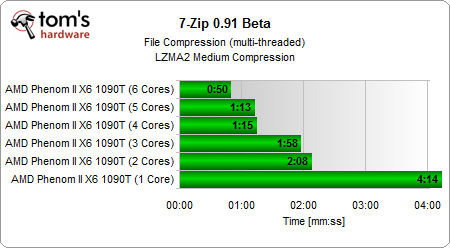Six-Core Analysis: AMD’s Phenom II X6 Gets Scaled Down
What’s the real benefit of six cores versus five, four, three, two, or one? This article looks at the performance, power, and efficiency of AMD's Thuban-based six-core Phenom II X6 1090T processor running with several different core configurations.
Benchmark Results: Applications
7-Zip doesn’t work well on an uneven number of cores. Three and five active cores are hardly faster than two and four. However, the archiving tools do generally benefit a lot from additional cores (the exception being WinZip).
The multi-threaded Cinebench test scales well while the single-threaded test run is limited, naturally.
Adobe’s Acrobat could be much faster if it only were optimized to take advantage of multiple processing cores. You can't squeeze much more out of it once you reach two processing cores at high clock speeds.
Photoshop is different, and benefits significantly from each core, although it's important to note that performance benefits may vary depending on the filters you apply. Some are thread-optimized; others aren’t.
WinRAR is a thread-optimized archiving tool, but it hits limits once you have four cores. Going to six doesn’t speed up your file management noticeably.
WinZip, which is considered the most popular archiving tool, delivers painful results. There are hardly any differences between one and six cores. Clearly, the software is fully single-threaded.
Get Tom's Hardware's best news and in-depth reviews, straight to your inbox.
Current page: Benchmark Results: Applications
Prev Page Benchmark Results: 3DMark And PCMark Vantage Next Page Benchmark Results: Audio/Video






